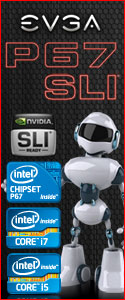Because we are using a Sandy Bridge platform the overclocking is pretty much limited to the memory ratios available in BIOS. Sure, you can make minor adjustments in the BCLK before stability issues become a major problem but we decided to just set the divider to 1866 and see if we could get that stable. Topower states this memory is overclockable and they were right! It took a little effort but we were able to get the memory stable enough to run the full battery of tests again. We needed to boost the memory voltage to right at 1.7v, raise the VCCIO a few notches and set the timings to 10-10-10-27 2T in order to stabilize things, but it was doable. The table below shows the benchmark scores before and after the overclock.
Test |
1600Mhz |
1866Mhz |
| WinRar | 3872 | 3963 |
| Cennebench OpenGL | 56.52 | 56.52 |
| Cinebench CPU | 8.76 | 8.76 |
| MaxxMem Copy | 22592 | 24732 |
| MaxxMem Read | 20643 | 22687 |
| MaxxMem Write | 21764 | 22406 |
| MaxxMem Latency | 50.2 NS | 48.2 NS |
| SuperPI 32M | 466.597 Sec | 466.024 Sec |
| SuperPI 1M | 8.331 Sec | 8.315 Sec |
| wPrime 10247M | 191.927 Sec | 191.394 Sec |
| wPrime 32M | 6.24 Sec | 6.24 Sec |
| AIDA64 Copy | 21936 | 24421 |
| AIDA64 Read | 19646 | 21404 |
| AIDA64 Write | 22135 | 22745 |
| AIDA64 Latency | 45.4 NS | 45.0 NS |
The only gains of note were in copy/read/write/latency scores and the WinRar compression test. The rest of the testing showing minimal, if any gains at all. This is due to those tests being more CPU dependent than memory. Still some nice increases in the AIDA64 and MaxxMem testing were had with the overclocked setting.
Of course everyone’s system is going to be different, but we suppose with some tweaking and a little patience these Topower Black-X modules can be made to run very stable at 1866Mhz on just about any system.

 Posted in
Posted in 






